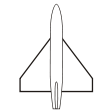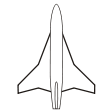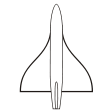Delta wing
.png)

The delta wing is a wing shaped in the form of a triangle. It is named for its similarity in shape to the Greek uppercase letter delta (Δ).
History
Early deltas
Triangular stabilizing fins for rockets were described ca. 1529-1556 by Conrad Haas and in the 17th century by Kazimierz Siemienowicz.[1][2][3]
The lifting delta wing was pioneered by Alexander Lippisch in Germany after World War I, initially using a very gentle angle so that the wing appeared almost straight. He flew the first tailless delta aircraft in 1931, followed by four improved designs.[4][5] None of these designs were easy to handle at low speed and none saw widespread service.[6][7]
During World War II Lippisch studied a more advanced tailless delta wing of greater angle intended for high-speed and even supersonic flight, for use in interceptor aircraft. One progressed as far as a glider prototype.[8]
The British later developed jet aircraft based on the data from Lippisch, notably the Avro Vulcan strategic bomber and the Gloster Javelin fighter. The Javelin incorporated a tailplane in order to rectify some of the perceived weaknesses of the pure delta, to improve low-speed handling and high-speed manoeuvrability and to allow a greater center of gravity range.[9]
Supersonic deltas

In America Robert T. Jones, working at NACA during World War II, developed a theory for supersonic delta wings. First published in January 1945, this approach differed from Lippisch's earlier work on thick delta wings by combining a delta planform with a thin airfoil. This design proved to be superior and would form the basis of all practical supersonic deltas such as those first made by Convair.[10][11]
The tailless delta became a favored design for high-speed aircraft, and was used almost to the exclusion of other designs by Convair and by Dassault Aviation, notably with the Dassault Mirage III. The F-102 Delta Dagger and Douglas F4D Skyray were two of the first operational jet fighters with a tailless delta wing when they entered service in 1956.[12]
The tailed delta configuration was again adopted by the TsAGI (Central Aero and Hydrodynamic Institute, Moscow), to take advantage of both high angle-of-attack flying capability and high speeds. It was used in the MiG-21 ("Fishbed") and Sukhoi Su-9/Su-11/15 fighters, built by the tens of thousands in several different communist countries.
Close-coupled canard delta
Through the 1960s Saab AB developed a close-coupled canard delta configuration, with a delta foreplane just in front of and above the main delta wing.[13] Patented in 1963, it first flew on the Viggen fighter in 1967. The close coupling modifies the airflow over the wing, most notably when flying at high angles of attack. In contrast to the classic tail-mounted elevators, the canards add to the total lift, enabling the execution of extreme maneuvers, improving low-speed handling and lowering the landing speed. This configuration has since become common on supersonic fighter aircraft.
Supersonic transport
When supersonic transport (SST) aircraft were developed, the tailless ogival delta wing was chosen for both the Anglo-French Concorde and the Soviet Tupolev Tu-144, the Tupolev first flying in 1968.
Design variations
Pure delta wings suffer from some undesirable characteristics, notably flow separation at high angles of attack (swept wings have similar problems), and high drag at low altitudes. This originally limited them primarily to high-speed, high-altitude interceptor roles. Since then the delta design has been modified in different ways to overcome some of these problems.
Canard delta – Many modern fighter aircraft, such as the JAS 39 Gripen, the Eurofighter Typhoon and the Dassault Rafale use a combination of canards and a delta wing.
Tailed delta – adds a conventional tailplane (with horizontal tail surfaces), to improve handling. Common on Soviet types such as the Mikoyan-Gurevich MiG-21.
Cropped delta – tip is cut off. This helps avoid tip drag at high angles of attack. Used for example in all three Eurocanards (cropped, tailless delta combined with a canard).
In another variant known variously as compound delta, double delta or cranked arrow, the inner part of the wing has a very high sweepback, while the outer part has less sweepback, to create the high-lift vortex in a more controlled fashion, reduce the drag and thereby allow landing at acceptably slow speed. This design can be seen on the Saab Draken fighter, the prototype F-16XL "Cranked Arrow" and in the High Speed Civil Transport study. The ogee delta (or ogival delta) used on the Anglo-French Concorde Mach 2 airliner is similar, but with a smooth ogee curve joining the two parts rather than an angle.
 Tailless delta |
 Tailed delta |
 Cropped delta |
 Compound delta |
 Cranked arrow |
 Ogival delta |
Aerodynamics
General characteristics
The long root chord and short span of the delta wing make it structurally efficient. It can be built stronger, stiffer and at the same time lighter than a swept wing of equivalent lifting capability. Its long root chord also allows a deeper structure for a given aerofoil section, providing more internal volume for fuel and other storage. Because of its light, robust structure it is easy and relatively inexpensive to build – a substantial factor in the success of the MiG-21 and Mirage aircraft.
The tailless delta wing is not suited to high wing loadings and requires a large wing area for a given aircraft weight. The most efficient aerofoils are unstable in pitch and the tailless type must use a less efficient design and therefore a bigger wing. Techniques used include:
- Using a less efficient aerofoil which is inherently stable, such as a symmetrical form with zero camber, or even reflex camber near the trailing edge,
- Using the rear part of the wing as a lightly- or even negatively-loaded horizontal stabiliser:
- Twisting the outer leading edge down to reduce the incidence of the wing tip, which is behind the main centre of lift. This also improves stall characteristics and can benefit supersonic cruise in other ways.
- Moving the centre of mass forwards and trimming the elevator to exert a balancing downforce. In the extreme, this reduces the craft's ability to pitch its nose up for takeoff and landing.
Low-speed characteristics

At low speeds a delta wing requires a high angle of attack to maintain lift. A slender delta creates a characteristic vortex pattern over the upper surface which enhances lift. Some types with intermediate sweep have been given retractable "moustaches" or fixed leading-edge root extensions (LERX) to encourage vortex formation.
As the angle of attack increases, the leading edge of the wing generates a vortex which energizes the flow on the upper surface of the wing, delaying flow separation, and giving the delta a very high stall angle. A normal wing built for high speed use typically has undesirable characteristics at low speeds, but in this regime the delta gradually changes over to a mode of lift based on the vortex it generates, a mode where it has smooth and stable flight characteristics.
The vortex lift comes at the cost of increased drag, so more powerful engines are needed to maintain low speed or high angle-of-attack flight.
Transonic and supersonic characteristics
With a large enough angle of rearward sweep, in the transonic to low supersonic speed range the wing's leading edge remains behind the shock wave boundary or shock cone created by the leading edge root.
This allows air below the leading edge to flow out, up and around it, then back inwards again in a conical flow pattern. The lift distribution and other aerodynamic characteristics are strongly influenced by this sideways flow.[14]
The rearward sweep angle lowers the airspeed normal to the leading edge of the wing, thereby allowing the aircraft to fly at high subsonic, transonic, or supersonic speed, while the over wing speed of the lifting air is kept to less than the speed of sound.
A characteristic of this flight regime is that drooping the leading edge within the cone increases lift but not drag.[15] Such conical leading edge droop was introduced on the production Convair F-102A Delta Dagger at the same time that the prototype design was reworked to include area-ruling. It also appeared on Convair's next two deltas, the F-106 Delta Dart and B-58 Hustler.[16]
At high supersonic speeds the shock cone from the leading edge root lies along the wing surface behind the leading edge. It is no longer possible for the sideways flow to occur and the aerodynamic characteristics change considerably.[14] It is in this flight regime that the waverider technique, as used on the North American XB-70 Valkyrie, becomes practicable.
The canard delta
A lifting-canard delta can offer a smaller shift in the center of lift with increasing Mach number compared to a conventional tail configuration.
An unloaded or free-floating canard can allow a safe recovery from a high angle of attack.
Depending on its design, a canard surface may increase or decrease longitudinal stability of the aircraft.[17][18]
A canard delta foreplane creates its own trailing vortex. If this vortex interferes with the vortex of the main delta wing, this can adversely affect the airflow over the wing and cause unwanted and even dangerous behaviour. In the close-coupled configuration, the canard vortex couples with the main vortex to enhance its benefits and maintain controlled airflow through a wide range of speeds and angles of attack. This allows both improved manoeuvrability and lower stalling speeds, but the presence of the foreplane can increase drag at supersonic speeds and hence reduce the aircraft's maximum speed.
The tailed delta
A conventional tail stabiliser allows the main wing to be optimised for lift and therefore to be smaller and more highly loaded.
When used with a T-tail as in the Gloster Javelin the large delta wing could give rise to a "deep stall"; at high angles of attack the wing nullified airflow over the tail and made the aircraft uncontrollable.[19]
See also
Notes
- ↑ "Corad Haas Raketenpionier in Siebenbürgen" [Corad Haas rocket pioneer in Transylvania]. Beruehmte Siebenbuerger Sachsen (in German). Siebenbürgen und die Siebenbürger Sachsen im Internet.
- ↑ New Rocket Guide (pdf), NASA.
- ↑ Orłowski, Bolesław (Jul 1973), Technology and Culture, 14 (3), JStor, pp. 461–73, JSTOR 3102331.
- ↑ Ford, Roger (2000). Germany's secret weapons in World War II (1st ed.). Osceola, WI: MBI Publishing. p. 36. ISBN 0-7603-0847-0.
- ↑ "New Triangle Plane Is Tailless", Popular Science, p. 65, December 1931.
- ↑ Madelung, Ernst Heinrich; Hirschel, Horst; Prem, Gero (2004). Aeronautical research in Germany: from Lilienthal until today (American ed.). Berlin: Springer. ISBN 3-540-40645-X.
- ↑ Wohlfahrt, Karl; Nickel, Michael (1990). Schwanzlose flugzeuge : ihre auslegung und ihre eigenschaften [Tailless aircraft: their design & properties] (in German). Basel: Birkhauser. pp. 577–78. ISBN 3-7643-2502-X. Retrieved 13 February 2011.
[Lippisch Delta I and Horten H I] Both these aircraft shown, how not to do it.
- ↑ Grommo (17 May 2008), Lippisch P13a Supersonic Ramjet Fighter footage (video), Youtube.
- ↑ Partridge, J (1967), Number 179 – The Gloster Javelin 1-6, Profile.
- ↑ Von Karman, Aerodynamics: Selected Topics in the Light of their Historical Development, 1954
- ↑ Richard Hallion, Lippisch, Gluhareff and Jones: The Emergence of the Delta Planform, Aerospace Historian, March 1979.
- ↑ "Early Supersonic Fighters of the West" Gunston Bill, Ian Allen Ltd. Shepperton, ISBN 0-7110-0636-9, 103/74, p.181 and 230
- ↑ Green, W; Swanborough, G (1994), The complete book of fighters, Salamander .
- 1 2 Mason, Chap. 10, Pages 9–12.
- ↑ Boyd, Migotzky and Wetzel; "A Study of Conical Camber for Triangular and Sweptback Wings", Research Memorandum A55G19, NACA, 1955.
- ↑ Mason, Chap. 10, Page 16.
- ↑ Probert, B, Aspects of Wing Design for Transonic and Supersonic Combat (pdf), NATO.
- ↑ Aerodynamic highlights of a fourth generation delta canard fighter aircraft, Mach flyg.
- ↑ Gloster Javelin History, UK: Thunder & Lightnings, 4 April 2012.
References
- Bradley, Robert (2003). "The Birth of the Delta Wing". J. Am. Aviation Hist. Soc.
- Guan, Jingling; Sritharan, S. S (2008). "A Problem of Hyperbolic-Elliptic Type Conservation Laws on Manifolds that Arises in Delta-Wing Aerodynamics" (PDF). International Journal of Contemporary Mathematical Sciences. 3: 721–37.
- Mason W.H.; "Configuration Aerodynamics", AOE 4124, Virginia Tech.
- Sritharan, S. S; Seebass, AR (1984). "A Finite Area Method for Nonlinear Supersonic Conical Flows". AIAA Journal. 22: 226–33. Bibcode:1984AIAAJ..22..226S. doi:10.2514/3.8372.
- Sritharan, S. S (1985). "Delta Wings with Shock-Free Cross Flow" (PDF). Quarterly of Applied Mathematics. XLIII: 275–86.
- Sritharan, S. S (1982), Nonlinear Aerodynamics of Supersonic Conical Delta wings (PDF) (Ph.D. Dissertation, University of Arizona, Applied Mathematics Program)
- "Computational simulation of supersonic delta wings", Uw acad Web (Microsoft Powerpoint) (presentation slides), Uwyo.
External links
| Wikimedia Commons has media related to Delta wings. |
| Look up delta wing in Wiktionary, the free dictionary. |